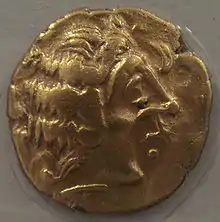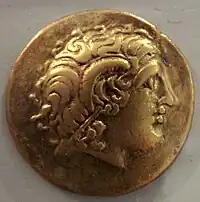
The Diablintes or Aulerci Diablites (also Diablintres or Diablindes) were a Gallic tribe dwelling in the north of the modern Mayenne department during the Iron Age and the Roman period. They were part of the Aulerci.[1]
Name
They are mentioned as Diablintes (var. Diablintres, Diablindes) by Caesar (mid-1st c. BC),[2] Diablinti by Pliny (1st c. AD),[3] Aúlírkioi hoi Diablítai or Diaultai (Αύλίρκιοι οἱ Διαβλίται/Διαυλται) by Ptolemy (2nd c. AD),[4] and as Diablentas by Orosius (early 5th c. AD).[5][6]
The meaning of the name is unclear. Pierre-Yves Lambert has proposed a connection with the Proto-Celtic root *dwēblo- ('double'; cf. Old Irish díabul), attached to an -e-nt- participial suffix, or perhaps to *anto-/*ento- ('face'; cf. Old Irish étan; also Bret. Daou-dal 'two-faced').[7]
The city of Jublains, attested ca. 400 as civitas Diablintum ('civitas of the Diablintes', Jublent ca. 1100) is named after the Gallic tribe.[8]
Geography
Julius Caesar (B. G. iii. 9) mentions the Diablintes among the allies of the Veneti and other Armoric states whom Caesar attacked. The Diablintes are mentioned between the Morini and Menapii. The territory of the Diablintes seems to have been small, and it may have been included in that of the Cenomanni, or the former diocese of Mans. (D'Anville, Notice, &c.; Walekenaer, Géog., &c. vol. i. p. 387.)
Their position can be calculated from Pliny's enumeration, Cariosvelites, Diablindi, Rhedones. The capital of the Diablintes, according to Ptolemy, was Noeodunum, probably the Nudium of the Table. The Notitia of the Gallic provinces, which belongs to the beginning of the fifth century, mentions Civitas Diablintum among the cities of Lugdunensis Tertia. A document of the seventh century speaks of condita Diablintica as situated in Pago Cenomannico (about modern Le Mans), and thus one location of the Diablintes is clear. This document also helps explain why Ptolemy used the name Aulerci for both the Diablintes and Cenomanni. Another document of the seventh century speaks of oppidum Diablintes juxta ripam Araenae fiuvioli; where the Arena (araenae) is recognised as the Aron, a tributary of the Mayenne. The small town of Jublains (or Jubleins), where Roman remains have been found, not far from the town of Mayenne to the southeast, is probably the site of the Civitas Diablintum and Noeodunum (also rendered Noiódounon; Νοιόδουνον).
A wooden tablet found in London records the sale of one Fortunata, a Diablintian slave girl.[9]
See also
References
- ↑ Kruta 2000, p. 440.
- ↑ Caesar. Commentarii de Bello Gallico, 3:9:10.
- ↑ Pliny. Naturalis Historia, 4:107.
- ↑ Ptolemy. Geōgraphikḕ Hyphḗgēsis, 2:8:7.
- ↑ Orosius. Historiae Adversus Paganos, 6:8.
- ↑ Falileyev 2010, s.v. Noiodounon Diablintum.
- ↑ Lambert 2005, s.v. Αὐλίρκιοι and οἱ Διαβλίνται.
- ↑ Nègre 1990, p. 154.
- ↑ The Real Lives of Roman Britain Guy De la Bédoyère, Yale University Press, 2015, page 54.
Bibliography
- Falileyev, Alexander (2010). Dictionary of Continental Celtic Place-names: A Celtic Companion to the Barrington Atlas of the Greek and Roman World. CMCS. ISBN 978-0955718236.
- Kruta, Venceslas (2000). Les Celtes, histoire et dictionnaire : des origines à la romanisation et au christianisme. Robert Laffont. ISBN 2-221-05690-6.
- Lambert, Pierre-Yves (2005). "The place names of Lugdunensis [Λουγδουνησία]". In de Hoz, Javier; Luján, Eugenio R.; Sims-Williams, Patrick (eds.). New approaches to Celtic place-names in Ptolemy's Geography. Ediciones Clásicas. pp. 215–251. ISBN 978-8478825721.
- Nègre, Ernest (1990). Toponymie générale de la France (in French). Librairie Droz. ISBN 978-2-600-02883-7.
![]() This article incorporates text from a publication now in the public domain: Smith, William, ed. (1854–1857). Dictionary of Greek and Roman Geography. London: John Murray.
This article incorporates text from a publication now in the public domain: Smith, William, ed. (1854–1857). Dictionary of Greek and Roman Geography. London: John Murray. {{cite encyclopedia}}: Missing or empty |title= (help)
